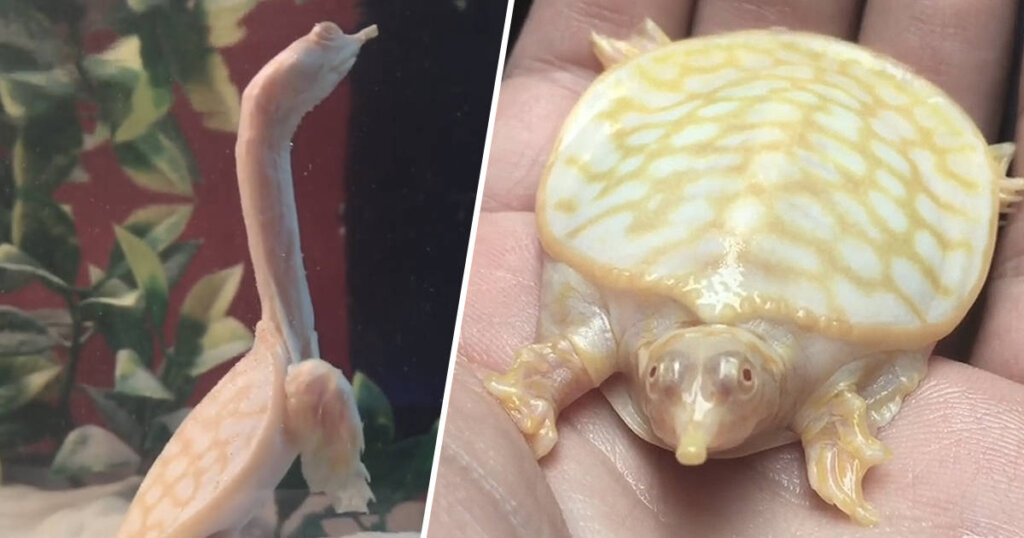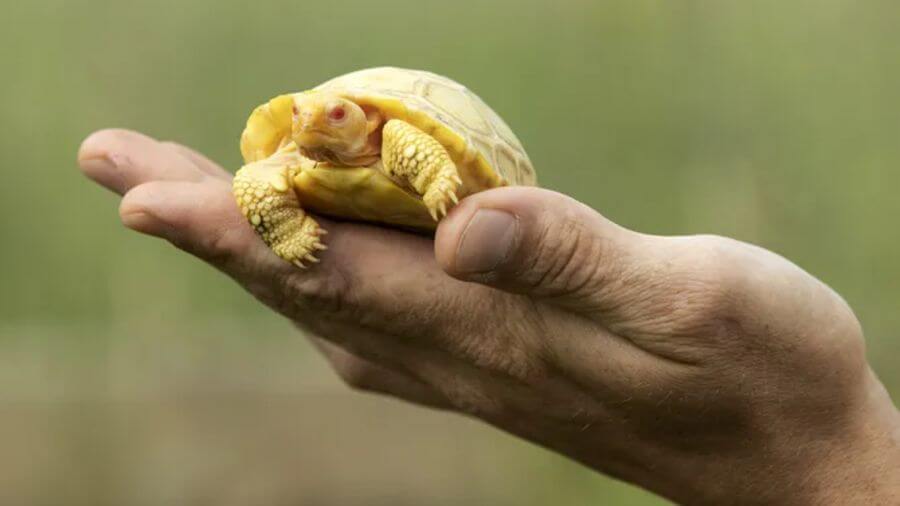The Incredibly Tiny Baby Albino Tortoise!

If you have never seen an albino tortoise, then don’t be surprised! It’s extremely rare to find them in the wild, as it’s a much less frequent mutation than in humans, and it can hinder their survival.
However, in a zoo in Switzerland, the first known albino Galapagos giant tortoise was born in May 2022. Here we’ll tell you all the details of this incredible event, so don’t miss it!
The Chelonoidis nigra complex
The Galapagos Islands were discovered in 1535 and, since then, their incredible biological diversity has been the subject of study for many biologists and scientists from other areas. And no wonder, as this archipelago is home to more than 2,000 endemic species.
This is why the Galapagos islands were designated a World Natural Heritage Site in 1976, a UNESCO Biosphere Reserve in 1984 and a Ramsar Site in 2001.
The name given to the Galapagos is no coincidence, since its most representative species are the giant tortoises that populate the islands. Most of the chelonian species that live here belong to the Chelonoidis nigra complex, consisting of 10 species, 2 of which are extinct.
That’s why we need to clarify that, even though the species from which the albino tortoise was born is called Chelonoidis nigra, we’re not talking here about the subspecies of the same name (the Floreana giant tortoise), as this has been extinct since 1996. In fact, the scientific name of this species is Chelonoidis niger.
Biology of the Galapagos giant tortoise
These animals, which can live more than 100 years, and weigh almost 200 kilograms (440 pounds), are terrestrial animals that only tread water to cool themselves during the hottest hours of the day. Their legs have short toes, similar to those of an elephant, and their carapace has a slit at the top to allow the turtle to stretch its neck and reach high branches and leaves.
Their diet is strictly herbivorous, and consists of grasses, shrub leaves, and the fruits of the manzanillo tree. Every day, Galapagos tortoises travel the same path to reach their feeding sites, so much so that the routes they carve have become part of the landscape.
In fact, these reptiles have a very fixed routine in their daily lives that is regulated by the seasons and the hours of daylight. The same trails that lead them to their food also take them to volcanic highlands, where they have access to drinking water and a large number of plants. There they will spend most of the day and then return to their resting places later.
The small albino tortoise of the Galapagos
Now that you know the species better, let’s get to the crux of the matter. At the Servion Zoo in Switzerland, a captive breeding program of the Galapagos giant tortoise was underway. Two offspring were born from the breeding pair, one black, like the father, and one albino.
This is a very rare occurrence. In figures, if one albino human is born every 20,000 people, in the case of this tortoise species, the probability is one in 100,000. In fact, this small albino turtle is the first albino turtle recorded by the scientific community.
In humans, albinism creates certain limitations, but, with tortoises, it can hinder their very survival. Being an ectothermic animal, the sensitivity to the sun that its albinism causes will create problems in thermoregulation.
It’s also possible for it to suffer from sight and hearing problems, as well as being much more visible to predators if it lived in the wild.
All attention is focused on the little turtle

Although the albino turtle was born on May 1, the news wasn’t published until June, as they weren’t sure whether it would survive, and kept it in an incubator. It is still under supervision, but no exact figure can be given on its life expectancy.
The importance of breeding programs and, above all, release into the wild are more than necessary when it comes to these reptiles. The total number of specimens of the Chelonoidis nigra complex , which was once more than 250,000 individuals, currently stands at no more than 15,000.
Intensive hunting since the 16th century, oil prospecting, habitat fragmentation and the introduction of foreign species by humans are just some of the threats to their populations. The reintroduction of many of them is being studied, but there’s still a long way to go.
All cited sources were thoroughly reviewed by our team to ensure their quality, reliability, currency, and validity. The bibliography of this article was considered reliable and of academic or scientific accuracy.
- Chelonoidis nigra (nigra). (s. f.). Animal Diversity Web. Recuperado 6 de julio de 2022, de https://animaldiversity.org/accounts/Chelonoidis_nigra/
- van Dijk, PP, Rhodin, AGJ, Cayot, LJ y Caccone, A. 2017. Chelonoidis niger . La Lista Roja de Especies Amenazadas de la UICN 2017: e.T9023A3149101. https://dx.doi.org/10.2305/IUCN.UK.2017-3.RLTS.T9023A3149101.en . Consultado el 06 de julio de 2022 .